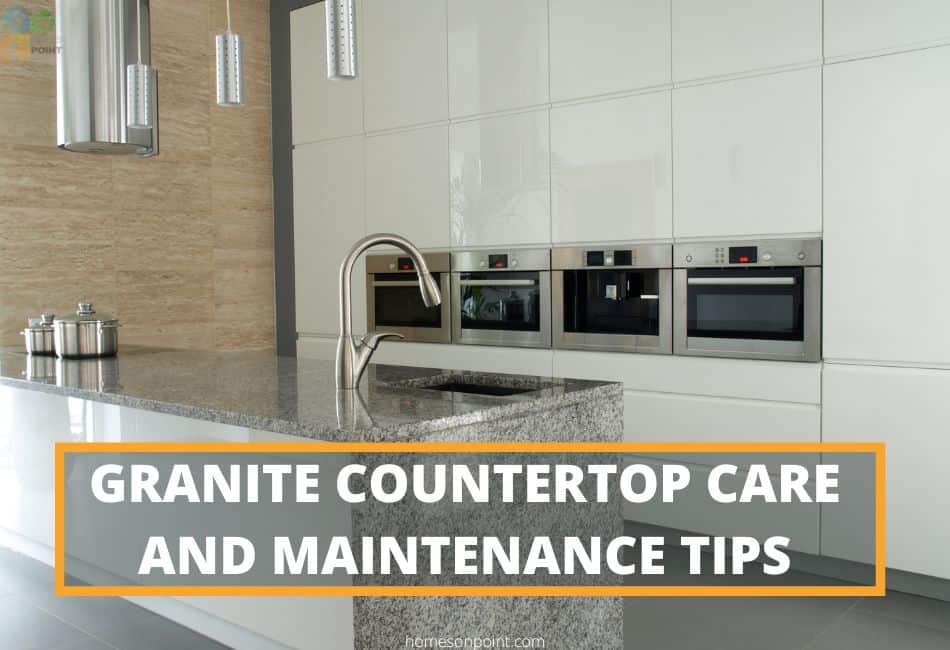Granite is a natural stone that is mined from the earth. It is then cut into slabs and transported to fabricators where it is made into countertops. Granite countertops come in different colors and patterns and textures. The most popular colors are black, white, and gray.
Granite is one of the hardest stones and is generally considered a very durable material. However, it is a natural product and does require some care to maintain its beauty and luster. In this article, we will discuss the do’s and don’ts of taking care of your granite countertops.
But first, let’s look at some features of granite countertops.
Features Of Granite Countertops
1. They are very durable
Granite countertops are one of the most durable countertop surfaces you can buy. Because of its durability, it is perfect for high-traffic areas in your home such as the kitchen or bathroom.
2. They are heat resistant
Granite countertops can withstand high temperatures. This makes them ideal for cooking areas where you might place hot pans on the countertop, although you should always use a trivet or hot pad to protect the countertop from direct contact with heat.
3. They are stain-resistant
Granite is a very dense material and when sealed properly, it is resistant to stains.
4. Scratch resistance
Granite is a very hard material and is resistant to scratches. The stone used is one of the hardest materials available. Chances are it will even blunt your knives but it is still recommended not to cut directly on the countertop.
5. Beautiful appearance
Granite countertops come in a wide range of colors and patterns. It is a natural product so each piece is unique. You can find granite countertops that match any décor, whether you are looking for a dark, dramatic look or a light and airy feel.
Do’s Of Granite Countertops
Now that we know some of the features of granite countertops, let’s look at the do’s of taking care of them.
1. Be vigilant about cleaning up spills
Granite countertops are stain-resistant, but not completely stain-proof. This means they can still be stained if not cared for properly. The sealant will help reduce the risk of staining, but it is still important to clean up spills quickly. Despite the sealant doing its work, granite is still a porous material and if deep colors are left to sit for a long time, they can seep into the countertop and cause a stain.
Use a clean, dry cloth to wipe up spills as soon as they happen. If the spill is oil-based, you may need to use mild dish soap and water to remove it. Be sure to rinse the countertop well after cleaning it with soap and water.
2. Keep acidic substances away from granite countertops
Acidic substances can damage the sealant on granite countertops and cause etching. Etching is when the acid eats away at the surface of the granite, leaving a dull spot. To avoid etching, keep acidic substances off of your countertop. If you spill something acidic, clean it up immediately.
3. Use sealant on granite countertops
Sealing your granite will help protect it from stains and other damage. Granite should be sealed based on the manufacturer’s specifications, but more often if it is used frequently. Most granite countertops come with a sealant already applied, but it is a good idea to check with the manufacturer or your fabricator to be sure.
4. Use coasters under glasses and cups
It is a good idea to use coasters under glasses and cups. This will help protect the countertop from any condensation that might form on the bottom of the glass. When condensation forms at the bottom of the glass, it will form ring marks on the countertop. Ring marks are made up of water and minerals that are left behind when the water evaporates. They can also be made up of alcohol and oils. They are ugly when present on your granite countertop, so it is best to avoid them altogether by using coasters as a barrier between your glass and the countertop.
5. Use cutting boards when chopping food
As we mentioned before, granite is a very hard material but it doesn’t mean it cannot develop scratches and knife marks when exposed to it. Its hardness also means that it can dull your knives if you use them directly on the countertop. It is best to use a cutting board when chopping food to protect your knives and the countertop.
When your granite countertop’s sealant is worn away due to the frequent use of sharp objects on it, its resistance to staining fades, making it more susceptible to staining easily.
6. Always use a soft cloth or sponge to clean the surface
To clean the surface of your granite countertop, always use a soft cloth or sponge. They are gentle enough to not damage the sealant or the surface of your countertop.
7. Clean your granite countertop regularly
Granite countertops should be cleaned on a regular basis. The frequency of cleaning will depend on how often the countertop is used. If it is used frequently, it will need to be cleaned more often. At a minimum, the countertop should be wiped down with a mild soap and water solution daily. This will prevent dirt and grime and bacteria from building up on the surface.
Don’ts Of Granite Countertops
There are also some things you should avoid doing to your granite countertop to keep it looking its best. These include
1. Avoid acidic cleaners on your granite countertop
Acidic cleaners can damage the sealant on your granite countertop, making it more susceptible to staining. Cleaners like bleach can eat away at the sealant and cause it to break down over time. In an attempt to get rid of tough stains like dye from countertops, some people use cleaners that are way too harsh. This ends up causing more damage in the long run.
Using harsh chemicals such as ammonia, bathroom cleaners, and oven cleaners to clean granite countertops should be avoided at all costs. They will cause permanent damage to your countertop.
2. Don’t put too much weight on your granite countertop
Your granite countertop is strong, but it can crack if too much weight is placed on it. Avoid putting heavy objects on your countertop, especially near the edges. If you do need to put a heavy object on your countertop, make sure it is evenly distributed and not concentrated in one area.
Standing or sitting on your countertop can also cause it to crack, so avoid doing that as well.
3. Avoid dragging pans and pots across the surface of your granite countertop
Empty pans and pots should also be lifted rather than dragged across the surface of your countertop. This can cause scratches. If you do need to drag something across the surface of your countertop, make sure it is covered with a towel or another soft material to prevent damage.
4. Do not put hot pans directly on your granite countertop
Hot pans can cause damage to your granite countertop. Although they are heat resistant, they can crack when exposed to extreme temperatures. This might not happen in one day but constant exposure to heat can eventually cause damage. Use a trivet or hot pad to protect your countertop from hot pans.
Placing a pot directly from the stove onto your countertop can also cause thermal shock. This happens when there is a sudden change in temperature and it causes the granite to crack. To avoid this, let the pot cool down before placing it on your countertop.
Also, once you remove the hot pan, the surface of your countertop will be very hot which can lead to burns if you accidentally touch it.
5. Do not use rough scouring pads on your granite countertop
Like quartz countertops, rough scouring pads and abrasive cleaners can damage the surface of your granite countertop. When used they will eliminate any dirt or stain but along with it will also be the sealant on your granite countertop, leaving the stone exposed. If you need to scrub something off your countertop, use a soft cloth or sponge with a mild cleaner.
6. Don’t assume the resealing period for your granite countertop
The resealing period for your granite countertop will depend on the type of sealer used, the porosity of the stone, and how often it is used. You should not wait until your granite countertop starts to look dull or stained before you reseal it. By then, it might be too late and the damage might be irreversible.
All granites are not the same and some types should never be sealed. If you have a sealed granite countertop, it’s best to err on the side of caution and test your granite countertop every six months to a year to know if it needs resealing. This will ensure that it is properly protected from stains and other damage.
7. Don’t cut directly on your granite countertop
Cutting directly on your granite countertop will lead to scratches and will also dull your knife. When sharp objects are used directly on the countertop without any barrier such as a chopping board, they can cut through the sealant, leaving the countertop unprotected and susceptible to damage.
Scratches on granite countertops may be fixed, but it’s worth avoiding them altogether to save money.
Final thoughts on granite countertops
Granite countertops are one of the most durable countertops you can have in your kitchen. To function properly, it must be cared for and avoided from doing activities that might damage it. With a little bit of care, your granite countertop will last for many years. Thanks for reading.


